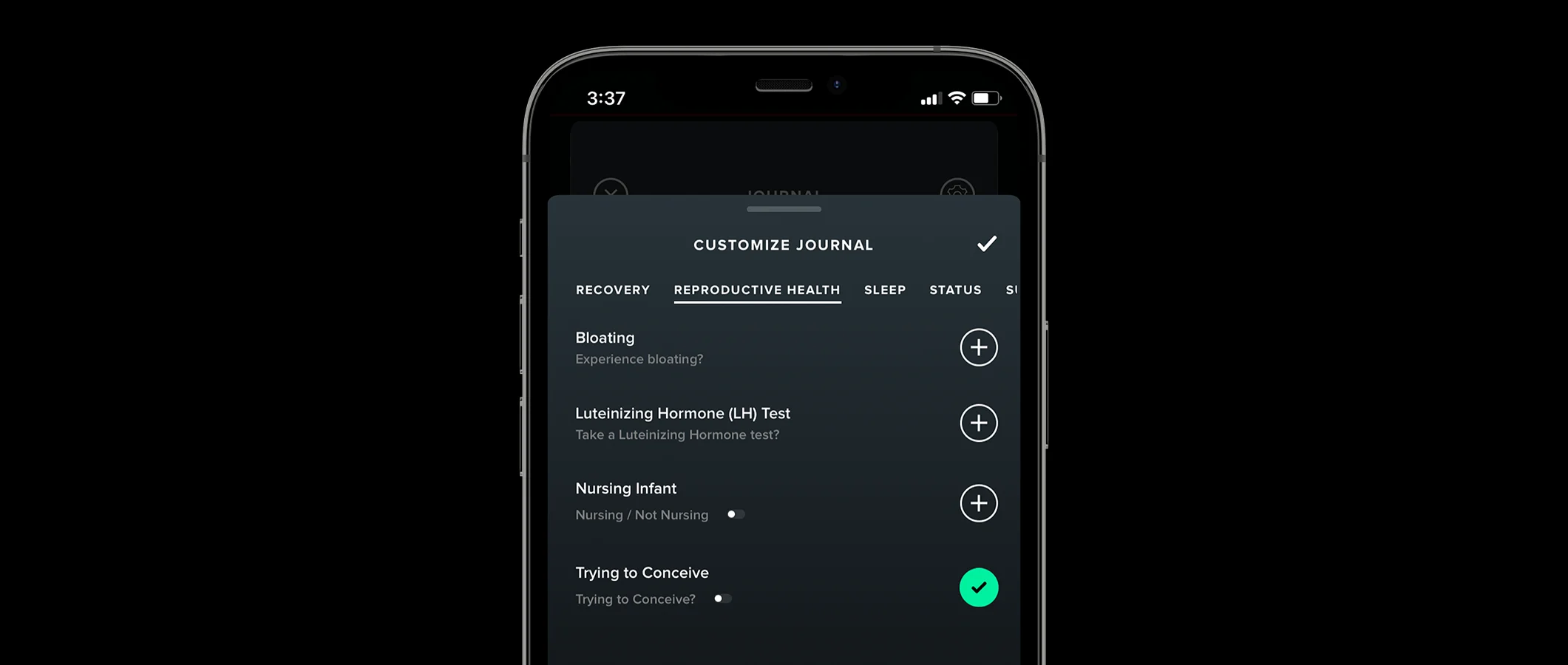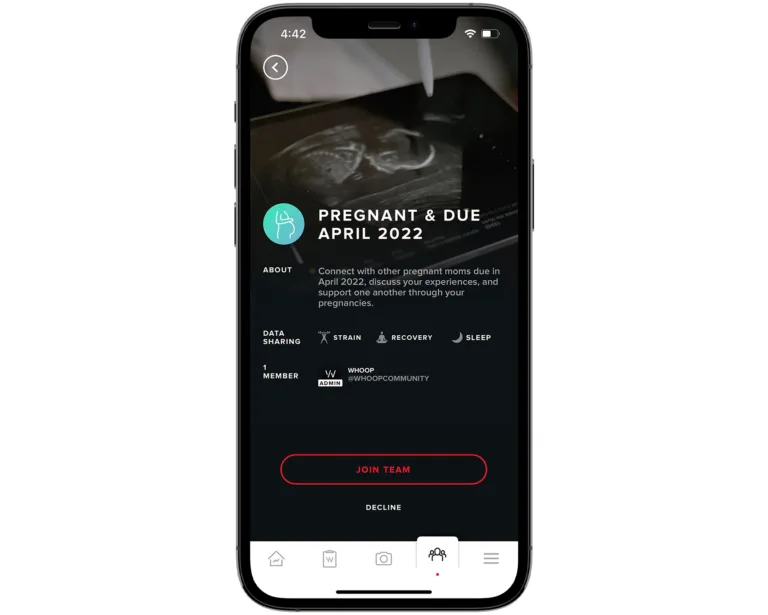Topics
- Article
- App & Features
- Women’s Performance
WHOOP Features Support Reproductive Health Through All Life Stages

The ability to personalize WHOOP means that members can track changes in their physiology across life milestones. That is why WHOOP launched pregnancy due date teams, added reproductive health toggles for all stages of life, and conducted the largest reproductive health study ever.
WHOOP is launching new features to help members understand how their individual physiology changes and how to optimize their sleep and workouts in every stage. In 2021, WHOOP initiated Menstrual Cycle Insights, and now we’re introducing new Journal toggles to track and better understand changes at every stage of life, from trying to conceive through postmenopause. Women go through numerous physiological changes in their lives that they can track by enabling reproductive health Journal toggles.
What's new
It’s now easier than ever to get insights about your cycle with this new auto-log feature. Automatically import data from Apple Health Kit and the period tracking apps you already use right into your Journal. Keeping track of changes to your reproductive health will help you see how your cycle impacts your recovery and overall health.
New WHOOP Features and Journal Toggles

WHOOP has reproductive toggles to help members track ovulation, trying to conceive, pregnancy, perimenopause and postmenopause. WHOOP has added new toggles for trying to conceive, perimenopause, and postmenopause to help you better understand how your body changes and personalize recommendations around different life stages. These are an addition to the existing pregnancy toggle and Menstrual Cycle Insights.
Menstrual Cycle WHOOP helps you track your menstrual cycle with Menstrual Cycle Insights. If you’re not using hormonal birth control, Menstrual Cycle Insights provides a deep dive into how the phases of your cycle affect your sleep and strain. It enables you to optimize your training and recovery based on where you are in your monthly cycle. Additionally, it can also help you learn what behaviors may influence symptoms like cramps and bloating, and how exercise and strain in different phases of your cycle impact you. For example, women’s nutrition expert Dr. Hazel Wallace notes that women’s bodies change the way they use carbohydrates and fat for fuel in different stages of the menstrual cycle. You can track your dietary habits in the Journal across your cycle and note things like nutrient intake, cravings, hunger levels, and energy levels, and learn how they impact your training, sleep, and recovery.
Trying to Conceive Trying to get pregnant isn’t always easy. Toggling “Trying to Conceive” or “Ovulating,” along with the Menstrual Cycle Insights helps you track ovulation so you can know your most fertile days in the month for the best chance to get pregnant. In a first-of-its-kind study from West Virginia University School of Medicine, WHOOP was used to monitor health trends of active pregnant women. It is the first study to track key biometric data using a wearable device throughout the participants’ entire pregnancy, before, during and after. Among other findings, a decrease in HRV and an increase in resting heart rate were observed after conception and before the first missed period. The results indicate that monitoring HRV and RHR daily could potentially be helpful in detecting pregnancy.
Pregnancy When you log your pregnancy in the Journal, you’ll be invited to join a Community team chat based on your due date where you can share experiences and find support from other pregnant members. Current guidelines on exercise during pregnancy have changed since first being issued in 1985 by the American College of Obstetricians and Gynecologists. But Dr. Shon Rowan, lead researcher on the WVU study, recently appeared on our podcast and said he still hears outdated recommendations from physicians. He pointed out that current recommendations from 2017 state that pregnant women perform moderate exercise 3-4 times a week and that it’s no longer a recommendation to not start an exercise regimen if you hadn’t before pregnancy. He hears more questions about what you can do, rather than what you can’t. “We can be more aggressive in letting women know what they can do,” he said. Former US National Team rower Sara Hendershot used WHOOP throughout her pregnancy in 2019, and saw interesting changes in her resting heart rate and HRV. “My body’s ability to take on strain also trended down over time, which was displayed by a decrease in heart rate variability and daily WHOOP strain scores. The six months prior to becoming pregnant, my average HRV was 64, compared to the first six months of pregnancy when it dropped to an average of 50.”
Postpartum Having a new baby takes a toll physically and mentally on parents. Logging nursing or parenting in the Journal will personalize WHOOP for this stressful phase of life. Dr. Rowan’s study found that in the 12 weeks after giving birth, women in the study had higher HRV scores compared to their baseline post pregnancy, meaning that these study participants were continuing to make fitness gains during their pregnancy. “So many women say ‘I’ve made amazing progress. I don't want to have a baby right now; I don’t want to hinder that progress I’ve made.’ We’re able to say you’re not hindering, you’re actually increasing your progress by getting pregnant. I think it will allow women to have that peace of mind that they’re not going to lose those gains that they worked hard for,” he said.
Menopause, Perimenopause, and Postmenopause Toggling perimenopause or postmenopause in the Journal will provide you with recovery insights in the Monthly Performance Assessment, so you can better track your symptoms and fine-tune your training. When you begin perimenopause (the multiyear transition stage before you completely stop getting your period and enter postmenopause), the most important thing is to track your symptoms, your sleep, and how you’re feeling, according to Dr. Stacy Sims, an expert in female physiology.
WHOOP Reproductive Health Study
Pregnant women have been excluded from medical studies for decades. Dr. Rowan calls the practice discriminatory and says that it’s led some physicians to providing outdated information to their patients who are trying to conceive or are pregnant. “There is a major knowledge and education gap when it comes to studying women’s health,” he says. We want to reverse this trend. WHOOP recently concluded the largest reproductive health study ever to advance research and help women better understand the changes they go through during all life stages: Menstruation, trying to conceive, pregnancy, postpartum, perimenopause, and postmenopause. “The vast majority of research that our training is based on actually doesn’t really apply to [women] or we don’t understand how it maybe needs to be modified to apply,” said WHOOP VP of Data Science and Research Emily Capodilupo during a recent episode of the WHOOP Podcast. The intent of this study is to help expand our understanding of how exercise affects sleep and recovery at every stage of women’s lives. Its findings will help provide personalized recommendations for WHOOP members based on whether they’re trying to conceive, nursing, going through perimenopause, and all the stages of an adult woman's life. Keep an eye out for the official research findings in the near future.